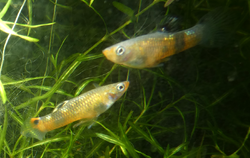Biology:Poecilia picta
| Swamp guppy | |
|---|---|

| |
| Gold morph males | |
| Scientific classification | |
| Domain: | Eukaryota |
| Kingdom: | Animalia |
| Phylum: | Chordata |
| Class: | Actinopterygii |
| Order: | Cyprinodontiformes |
| Family: | Poeciliidae |
| Genus: | Poecilia |
| Species: | P. picta
|
| Binomial name | |
| Poecilia picta Regan, 1913
| |
| Synonyms | |
| |
Poecilia picta, the swamp guppy, is a species of livebearer fish found in South America. It is closely related to the common guppy, P. reticulata, and shares its geographic range but tends to be found in more brackish environments.
Taxonomy
P. picta forms a clade with P. parae that is a sister taxon to the common guppy, P. reticulata.[2] Some authorities place the species in the genus Poecilia, subgenus Lebistes, along with P. reticulata, P. parae, P. branneri, and P. amazonica; others place it in the genus Micropoecilia along with P. parae and P. branneri.[3]
Description
Males grow to about 18 mm; females reach sexual maturity at that size too but, as in most other poeciliids, continue to grow, reaching 20 mm.[4] Males also differ from females by being more colorful, with black-spotted bodies and black, yellow, or orange coloration in their dorsal and caudal fins. Three color morphs exist in the wild among males: standard, red, and gold. The colorful forms are known from mainland populations but not from the insular.[2]
Distribution and habitat
P. picta is distributed throughout northeastern South America, including Guyana, Suriname, and Venezuela, and the Caribbean islands, a range it shares with the closely related guppies P. reticulata and P. parae.[2][5]
P. picta occurs in lowland habitats such as slowly-flowing waters at stream mouths and still water lagoons. These are often brackish.[4] It tolerates a wide range of salinity levels but gradually disappears from upstream freshwater sites due to competition with P. reticulata, which in turn avoids higher levels of salinity. The two species rarely form mixed shoals.[4][5] P. picta commonly congregates among marginal aquatic plants.[4]
Ecology
P. picta is omnivorous, feeding on cyanobacteria and animal matter.[6] Potential predators found in its habitats include Polycentrus schomburgkii, Hoplias malabaricus, Synbranchus marmoratus, Astyanax bimaculatus, and Roeboides dayi, the first two of which frequently prey on fish.[4]
Reproduction
P. picta is a livebearer.[4] Males engage in a courtship display which involves circling the female's head and may be accepted or rejected by females. In stark contrast to the closely related P. reticulata and P. parae, P. picta females show no preference for males with pronounced red or orange coloration.[2] Females carry only one brood at a time. Larger females deliver more fry, with the number normally ranging from 7 to 11,[4] but can reach 25 too.[7]
References
- ↑ Lasso, C. (2023). "Poecilia picta". The IUCN Red List of Threatened Species 2023: e.T176028334A176028354. doi:10.2305/IUCN.UK.2023-1.RLTS.T176028334A176028354.en. https://www.iucnredlist.org/species/176028334/176028354. Retrieved 5 January 2024.
- ↑ 2.0 2.1 2.2 2.3 Lindholm, Anna K.; Sandkam, Ben; Pohl, Kristina; Breden, Felix (3 November 2015). "Poecilia picta, a close relative to the guppy, exhibits red male coloration polymorphism: A system for phylogenetic comparisons :3". PLOS One 10 (11): e0142089. doi:10.1371/journal.pone.0142089. PMID 26529081. Bibcode: 2015PLoSO..1042089L.
- ↑ Breden, F; Ptacek, MB; Rashed, M; Taphorn, D; Figueiredo, CA (1999). "Molecular phylogeny of a live-bearing fish genus Poecilia (Poeciliidae: Cyprinidontiformes)". Molecular Phylogenetics and Evolution 12 (2): 95–104. doi:10.1006/mpev.1998.0600. PMID 10381313. https://www.academia.edu/933658. Retrieved 4 January 2024.
- ↑ 4.0 4.1 4.2 4.3 4.4 4.5 4.6 Reznick, David N.; Miles, Donald B.; Wilson, Steven (1992). "Life history of Poecilia picta (Poeciliidae) from the island of Trinidad". Copeia 3 (3): 782–790. doi:10.2307/1446155. https://www.jstor.org/stable/1446155. Retrieved 4 January 2024.
- ↑ 5.0 5.1 Torres-Dowdall, Julián; Dargent, Felipe; Handelsman, Corey A.; Ramnarine, Indar W.; Ghalambor, Cameron K. (April 2013). "Ecological correlates of the distribution limits of two poeciliid species along a salinity gradient". Biological Journal of the Linnean Society 108 (4): 790–805. doi:10.1111/bij.12031. https://academic.oup.com/biolinnean/article/108/4/790/2415778. Retrieved 4 January 2024.
- ↑ Sanchez, Jessica L.; Bracken-Grissom, Heather; Trexler, Joel C. (2019). "Freshwater-to-marine transitions may explain the evolution of herbivory in the subgenus Mollienesia (genus Poecilia, mollies and guppies)". Biological Journal of the Linnean Society 27 (4): 753. https://par.nsf.gov/servlets/purl/10122376. Retrieved 20 August 2023.
- ↑ Keith, Philippe; Le Bail, Pierre-Yves; Planquette, Planquette (2000). "Atlas des poissons d'eau douce de Guyane" (in French). Journal of Applied Ichthyology (Paris) 2 (1): 286. doi:10.1111/jai.12275. https://www.researchgate.net/publication/279530330. Retrieved 3 January 2024.
Wikidata ☰ Q106389620 entry
 |


